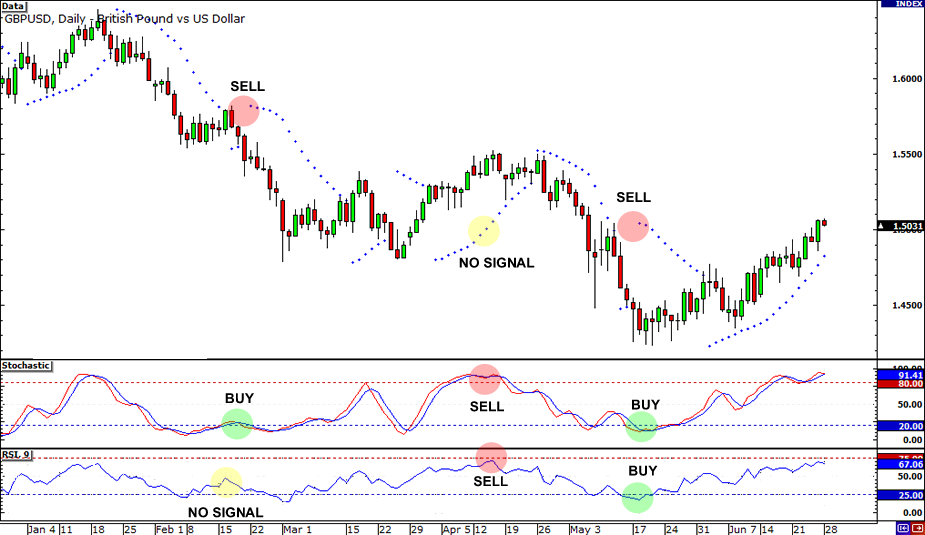Forex traders should consider creating custom oscillators to tailor the technical analysis tools to their trading strategies. This allows traders to receive more precise signals based on specific market conditions and reduce noise. Custom oscillators are also highly volatile and liquid, helping traders time their trades better.
In this article, we will discuss how traders can customize oscillators to personalize their trading.
What are custom oscillators?
Custom oscillators are variations of standard oscillators customized to fit specific trading strategies. They help traders identify potential market trends and reversals. With custom oscillators, traders can modify parameters such as time frame length, smoothing methods, overbought/oversold levels, weighting factors, and more.

How to customize oscillators
Analyze currency pair characteristics
Each currency pair has a different level of volatility. Pairs that are more volatile require a more responsive oscillator, whereas pairs with low volatility work well even with slow-responsive oscillators. The trader should analyze which type of currency pairs they are trading to customize the oscillator accordingly.
Select appropriate oscillator settings
Next, the trader should choose a time frame length that matches their trading style and currency pair volatility. The overbought and oversold levels can also be adjusted from the traditional 70 and 30 (respectively) to levels that suit the trader’s trading goals. For example, to trade volatile pairs, traders can change the overbought and oversold levels to 70 and 30, respectively. This will help traders time their trades better with fast-changing prices.
Configure oscillator sensitivity
The oscillator’s sensitivity can be configured by modifying the smoothing methods. A higher sensitivity helps capture more signals and considers higher noise, whereas a lower sensitivity provides smoother trade signals and fewer false alerts. The former can be suitable in the long term due to less noise, and the latter can be suitable for trading forex with a custom oscillator in the short term due to more noise.
Incorporate forex-specific parameters
A custom oscillator’s parameters can be adjusted before or after major economic events, data releases, geopolitical events, and more. This helps traders prepare for a volatile market with sharp price moves that may only last a short time.
Test across different market conditions
Traders should then run their custom oscillators through a historical test to see how the indicator would perform in different market conditions and timeframes. Select timeframes and market conditions that suit the trader’s current trading strategy. This helps traders decide whether to move forward with the custom oscillator or change the parameters.
Once the traders are sure that the custom oscillators will work for them, they can use a demo account to check the oscillator in real-time market conditions and then shift to live trading.
Use multiple timeframes
Analyzing the custom oscillator of multiple timeframes provides traders with a broader view of market conditions. It helps validate signals across different periods. The custom indicator is reliable if the signals from multiple timeframes align with the trader’s strategy.
Incorporate risk management features
Traders can adjust stop-loss orders and risk ratios based on the custom oscillator’s signals. Position sizes can also be adjusted based on the confidence level of the oscillator’s signals.
Evaluate the impact of correlated currency factors
Finally, traders should analyze how different currency pairs are correlated with one another, as this might affect the custom oscillator’s performance.
Correlations between different currency pairs may lead to misleading signals by the oscillator if one pair moves inversely. Hence, the oscillator’s effectiveness can be negatively affected and not tell traders a single pair's true strength or weakness. The oscillator should be used in combination with other technical indicators to ensure accurate trading signals.
*This is an example only to enhance a consumer's understanding of the strategy being described above and is not to be taken as Blueberry providing personal advice.
Risks and advantages of using custom oscillators
Risks
Integration issues
There is a chance that custom oscillators might not integrate properly with an existing trading platform or technical analysis tools. This can lead to compatibility issues, delayed executions, signal interpretation errors, and complexity in trading analysis.
Potential for misleading signals
If traders do not properly calibrate a custom oscillator, it may produce misleading or false signals. This can occur due to overfitting or entering incorrect parameter settings. This will ultimately lead traders into making poor trading decisions and substantial losses.
Calibration difficulties
Calibration is the process of adjusting the parameters of the trading indicators to ensure that they reflect accurate market conditions and generate reliable trading signals. However, finding optimal parameter settings for any custom indicator is challenging as it requires extensive testing. Inaccurate calibration can lead to lowered indicator effectiveness and responsiveness.
Advantages
Better signal filtering
Traders can tailor custom oscillators to specific market conditions, time frames, and trading strategies. This allows the custom oscillators to provide precise signals aligning with an individual’s trading goals and increasing entry/exit order accuracy.
Better market analysis
With a custom oscillator, traders can incorporate unique insights into their trading analysis. This leads to a deeper market analysis that may be missed with traditional oscillators. Hence, traders receive a much broader understanding of market trends to make better trading decisions.
Highlights market anomalies
Custom oscillators help traders detect unusual market trends or behaviors that standard oscillators might miss. This gives traders early warning signals of potential market reversals that are not present on the price chart. Hence, traders can gain a first-mover advantage and place orders accordingly.
Improving trading strategies with customized oscillators
Using custom oscillators to improve trading strategies gives traders a tailored market analysis that fits well with specific market conditions and currency pairs. However, with advantages come risks, so custom oscillators are susceptible to delivering misleading signals if not adjusted properly. Traders should ensure that they use these custom oscillators in conjunction with other technical indicators to avoid any inaccuracies in the market.
Disclaimer: All material published on our website is intended for informational purposes only and should not be considered personal advice or recommendation. As margin FX/CFDs are highly leveraged products, your gains and losses are magnified, and you could lose substantially more than your initial deposit. Investing in margin FX/CFDs does not give you any entitlements or rights to the underlying assets (e.g. the right to receive dividend payments). CFDs carry a high risk of investment loss.




